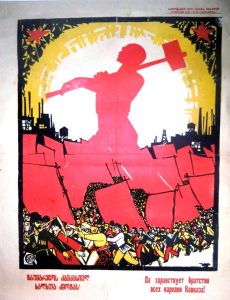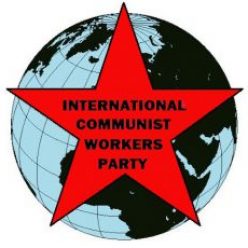War in the Caucasus: Real Communism Ends Borders and Nations
“I feel very sad about what is going on in my motherland (Armenia),” confided a co-worker.
“In 1915 the Turkish government killed over 1.5 million Armenians. To this day, the Turkish government denies this Armenian genocide. My grandparents are genocide survivors who fled to Syria. Armenians are afraid that the Turkish nations want to ethnically cleanse the Armenians. Turkey has many times said they want to finish off the Armenian race and have all Turkic nations border one another.
“Nagorno-Karabakh borders Azerbaijan. It got bombed and shelled starting September 26. Civilian buildings, schools, hospitals were all targeted. The Armenian military quickly realized that they were fighting Turkish forces, Syrian mercenaries and ISIS as well as the Azerbaijani military. There have been two ceasefires, but they only lasted a total of ten minutes.”
“Thank you,” a comrade responded. “Bolshevik policy on ‘the national question’ was disastrous. They allied with nationalist leaders who opposed imperialism. That led them to support governments in Turkey and Iran that were murdering communists.
“Globally, humans have migrated so much and for so long. Homogeneous national territories are no longer possible or desirable. People need to unite on the basis of shared class and human interests. That won’t happen until genocidal prejudices can be overcome.”
Communism and the “National Question”
The International Communist Workers’ Party is not a federation of national parties. All our members are comrades in one international party for one international working class.
We all fight against imperialism. Against racist, religious and communal divisions. Against nationalism and patriotism. We fight together for one communist world.
Lenin and the Bolsheviks struggled with the contradiction between national- and class-consciousness. In particular, when Lenin welcomed the League of Armenian Social-Democrats into the Russian Social-Democratic Labor Party in 1903.
The Armenian socialists declared themselves “for the interests of the Russian proletariat in general, and of the Armenian proletariat in particular.” The future Russia should be a “federative republic with local self-governments” to safeguard all its diverse groups.
They noted “the absence of geographical boundaries between the various nationalities.” They therefore demanded cultural but not political autonomy.
Lenin applauded the League’s line of “complete equality, rather than national autonomy” and for “the right to self-determination.” But he noted the contradiction of calling for a “federative republic” while denying the “political autonomy” of its units.
Instead, Lenin proposed to “rally the greatest possible masses of workers of each and every nationality more closely for struggle for a democratic republic and for socialism.” Today, our party rallies the masses for communism and nothing less.
Given his line, Lenin strained to interpret the “right to self-determination.” He concluded it meant “oppos[ing] any attempt to influence national self-determination from without by violence or injustice.” (That is, by imperialists.)

1921 poster: “Long live the brotherhood of all Caucasus nations”
Armenia, Azerbaijan and the USSR
By 1920 the Bolshevik line on “the national question” had changed for the worse, largely under Stalin’s influence. The new line would be fiercely contested, especially by communists in India and Iran.
In Transcaucasia, conflict had sharpened after the defeat of the Ottoman Empire and the fall of the Russian Czar. As Turkish troops retreated, Britain took control. Its eyes were on Baku oil. British imperialism lay the groundwork for incorporating Nagorno-Karabakh into Azerbaijan.
Both Armenia and Azerbaijan had geographic and historical arguments for their claims to “mountainous Karabakh.” Armenians were a majority of its permanent residents, but Azeri nomads regularly travelled between Karabakh’s mountains and its lowlands in Azerbaijan.
Fighting broke out in March 1918. The Bolsheviks, officially neutral, quietly supported Armenia. Ottoman Turks fought for Azerbaijan.
The First Congress of the Armenians of Karabakh proclaimed the region’s independence. In November 1919, Armenians formed a revolutionary Soviet government. A month later, Soviet Azerbaijan renounced its claim to the disputed provinces.
Armenia and Azerbaijan joined the new Union of Soviet Socialist Republics (USSR). As our friend put it, “Armenia joined the USSR to avoid massacres and get help.”
The USSR was the “federation” that Armenian socialists had proposed (and Lenin rejected) in 1903. For 60 years it managed to avoid Armenian-Azerbaijani fighting. But it failed to build communist class consciousness.
After the USSR collapsed in 1991, Armenia and Azerbaijan became independent states. The mainly-Armenian “autonomous region” of Nagorno-Karabakh also voted for independence. This triggered another war. Armenians regained control in 1994 but Azerbaijan never accepted that.
Today the “Artsakh Republic” in Nagorno-Karabakh is again a flashpoint in the deadly struggle among imperialists and regional capitalists for control of critical energy resources.
Transcaucasia has been a multi-ethnic region for centuries. Armenian socialists were correct in 1903 when they said that geographic borders did not correspond with “nationalities.”
Workers’ struggles there – notably in industrial Baku – have always crossed linguistic, cultural and religious barriers. The communist movement there reflected this diversity but failed to draw the correct conclusion: Nationalism and communist internationalism are incompatible.
Workers of the world, unite for communism! No borders! No nations!

